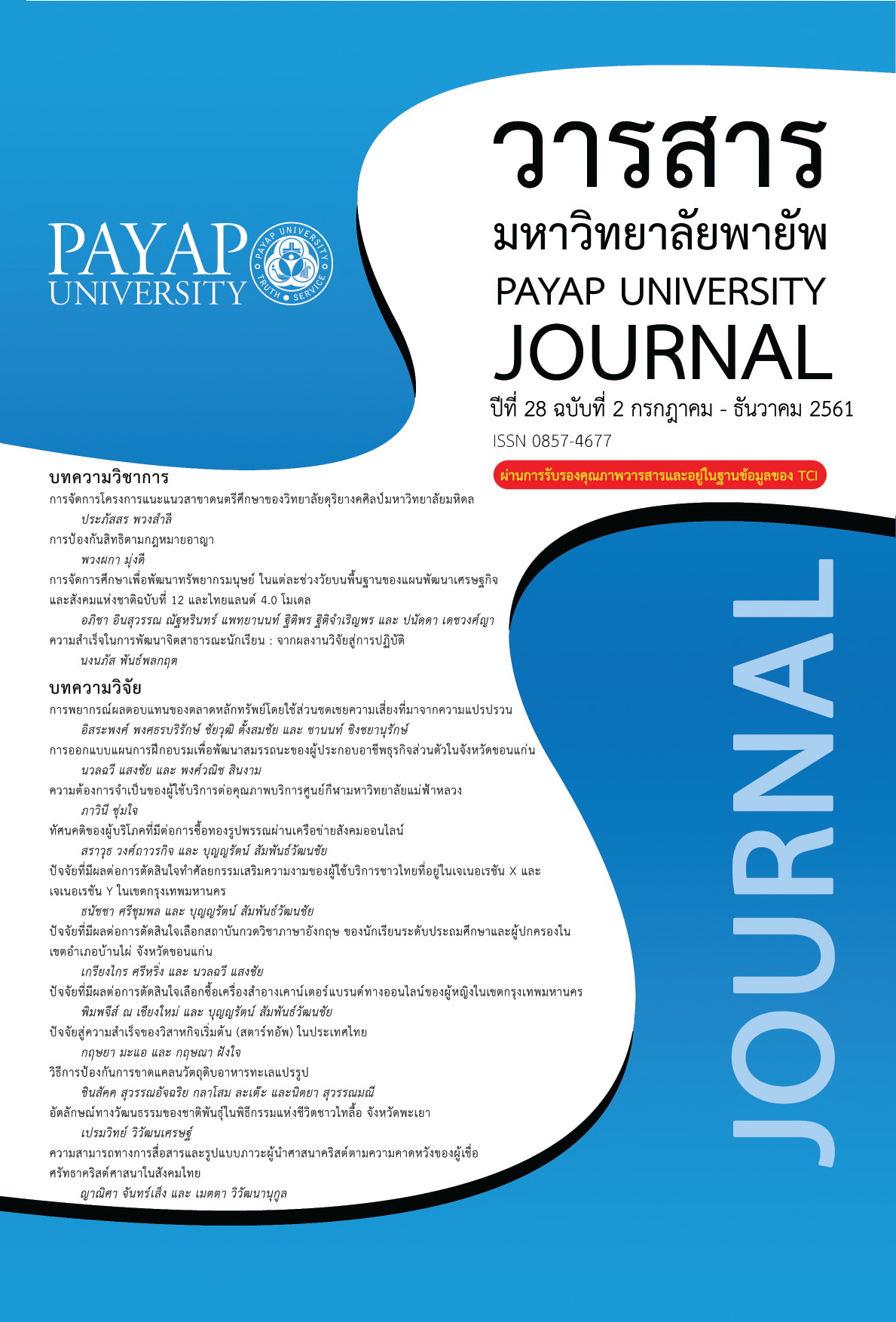การพยากรณ์ผลตอบแทนของตลาดหลักทรัพย์โดยใช้ส่วนชดเชยความเสี่ยงที่มาจากความแปรปรวน
Main Article Content
บทคัดย่อ
การศึกษาเรื่องการพยากรณ์ผลตอบแทนของตลาดหลักทรัพย์โดยใช้ส่วนชดเชยความเสี่ยงที่มาจากความแปรปรวน มีวัตถุประสงค์เพื่อศึกษาความสามารถในการพยากรณ์ผลตอบแทนของตลาดหลักทรัพย์แห่งประเทศไทยจากดัชนี SET50 โดยใช้ข้อมูลส่วนชดเชยความเสี่ยงที่มาจากความแปร ปรวน ตั้งแต่เดือน ตุลาคม พ.ศ. 2555 ถึงเดือน สิงหาคม พ.ศ. 2558 รวมทั้งสิ้น 35 เดือน ส่วนชดเชยความเสี่ยงที่มาจากความแปรปรวนคำนวณจากผลต่างระหว่างความแปรปรวนของราคาหลักทรัพย์อ้างอิงและความแปรปรวนของราคาหลักทรัพย์ ทำให้ส่วนชดเชยความเสี่ยงที่มาจากความแปรปรวนให้ข้อมูลเกี่ยวกับระดับความกลัวความเสี่ยงของนักลงทุนที่มีต่อราคาหลักทรัพย์อ้างอิงในอนาคต
ผลการทดสอบความสามารถในการพยากรณ์ผลตอบแทนของตลาดหลักทรัพย์แห่งประเทศไทยโดยใช้ส่วนชดเชยความเสี่ยงที่มาจากความแปรปรวน พบว่าส่วนชดเชยความเสี่ยงที่มาจากความแปรปรวนสามารถใช้ในการพยากรณ์ผลตอบแทนเฉลี่ยของตลาดหลักทรัพย์แห่งประเทศไทยในช่วงของผลตอบแทนเฉลี่ยราย 1 เดือน 9 เดือน 10 เดือน 11 เดือนและ 12 เดือน นอกจากนั้นเมื่อเปรียบเทียบความสามารถในการพยากรณ์ผลตอบแทนของตลาดหลักทรัพย์โดยใช้อัตราส่วนราคาต่อกำไรและอัตราส่วนเงินปันผลตอบแทน พบว่าทั้งสองตัวแปรมีความสามารถในการพยากรณ์ผลตอบแทนของตลาดหลักทรัพย์ได้ดีกว่าส่วนชดเชยความเสี่ยงที่มาจากความแปรปรวน ในส่วนสุดท้ายเมื่อใช้ส่วนชดเชยความเสี่ยงที่มาจากความแปรปรวนพยากรณ์ร่วมกับอัตราส่วนเงินปันผลตอบแทน สามารถพยากรณ์ผลตอบแทนได้ดีขึ้น เมื่อเปรียบเทียบกับการพยากรณ์โดยใช้ตัวแปรเดียว พยากรณ์ผลตอบแทนเฉลี่ยราย 10 เดือนได้ดีที่สุด
Article Details
เอกสารอ้างอิง
Bollerslev, T., Tauchen, G. and Zhou, H. (2009). Expected Stock Return and Variance Risk Premia. The Review of Financial Studies, 22, 4463-4489.
Bollerslev, T. Marrone, J., Xu, L. and Zhou, H. (2013). Stock Return Predictability and Variance Risk Pemia: Statistical Inference and International Evidence. Journal of Financial and Quantitative Analysis, 49, 633-661.
Cheng, J. (2015). Volatility Forecasting and Volatility Risk Premium. Journal of Applied Mathematics and Physics, 3, 98-102.


